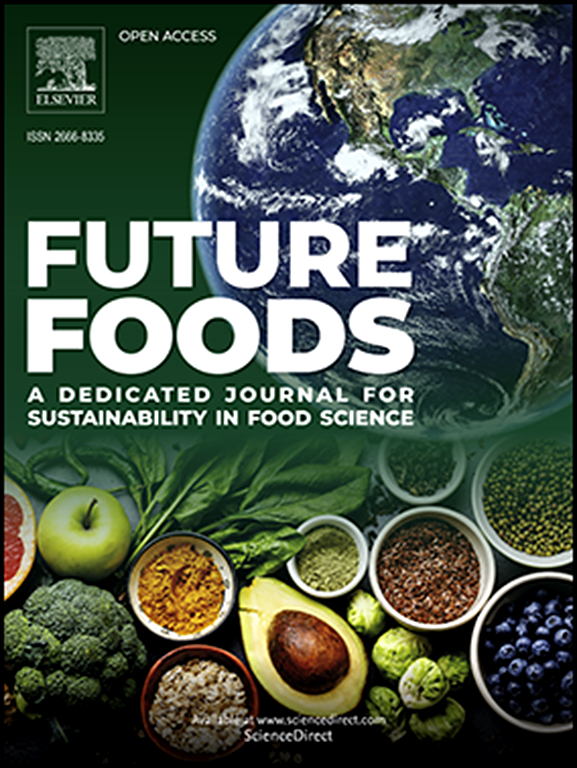Next-gen nutrition: Challenges, innovations and opportunities in 3D food printing with probiotics
IF 8.2
Q1 FOOD SCIENCE & TECHNOLOGY
引用次数: 0
Abstract
In this era of food innovation, the integration of health-promoting components into food products has become a key focus of research. Probiotics, well known for their beneficial effects on human health, are increasingly being incorporated into processed foods. Among the different methods, 3D food printing technology has recently gained significant attention. Probiotics in 3D printed foods interact with different food matrices and offer challenges marinating their viability in the gastrointestinal (GI) tract. The success of probiotics in 3D printed food products depends on several factors, including the interaction between probiotics and food matrices as well as the choice of suitable 3D printing materials. The stability of probiotics is influenced by the physical and chemical properties of the food matrices. In addition, the printing parameters such as temperature, extrusion method, and material viscosity play a crucial role in ensuring the effective delivery of probiotics. 3D food printing thus presents promising applications in the fields of personalized nutrition, food innovation, and health management. However, there are significant challenges in terms of standardization of food printing safety, regulation, and consumer acceptance that must be addressed to ensure its rapid annual expansion. This review aims to provide a comprehensive overview of the applications of probiotics in 3D printed food products. The review also highlights the potential of 3D food printing to address several contemporary challenges in food production, including the creation of visually appealing and textured foods, development of personalized nutrition solutions, sustainable availability and reduction in food insecurity.

下一代营养:益生菌3D食品打印的挑战、创新和机遇
在这个食品创新的时代,将促进健康的成分整合到食品中已成为研究的重点。众所周知,益生菌对人体健康有益,因此越来越多地加入到加工食品中。在不同的方法中,3D食品打印技术最近受到了极大的关注。3D打印食品中的益生菌与不同的食物基质相互作用,并对其在胃肠道中的生存能力提出了挑战。益生菌在3D打印食品中的成功取决于几个因素,包括益生菌和食品基质之间的相互作用以及合适的3D打印材料的选择。益生菌的稳定性受食品基质理化性质的影响。此外,温度、挤出方式、材料粘度等打印参数对确保益生菌的有效输送起着至关重要的作用。因此,3D食品打印在个性化营养、食品创新和健康管理等领域呈现出广阔的应用前景。然而,在食品印刷安全、监管和消费者接受的标准化方面,必须解决重大挑战,以确保其快速的年度扩张。本文综述了益生菌在3D打印食品中的应用。该审查还强调了3D食品打印在解决食品生产中的几个当代挑战方面的潜力,包括创造视觉吸引力和质地的食品,开发个性化营养解决方案,可持续供应和减少粮食不安全。
本文章由计算机程序翻译,如有差异,请以英文原文为准。
求助全文
约1分钟内获得全文
求助全文
来源期刊

Future Foods
Agricultural and Biological Sciences-Food Science
CiteScore
8.60
自引率
0.00%
发文量
97
审稿时长
15 weeks
期刊介绍:
Future Foods is a specialized journal that is dedicated to tackling the challenges posed by climate change and the need for sustainability in the realm of food production. The journal recognizes the imperative to transform current food manufacturing and consumption practices to meet the dietary needs of a burgeoning global population while simultaneously curbing environmental degradation.
The mission of Future Foods is to disseminate research that aligns with the goal of fostering the development of innovative technologies and alternative food sources to establish more sustainable food systems. The journal is committed to publishing high-quality, peer-reviewed articles that contribute to the advancement of sustainable food practices.
Abstracting and indexing:
Scopus
Directory of Open Access Journals (DOAJ)
Emerging Sources Citation Index (ESCI)
SCImago Journal Rank (SJR)
SNIP
 求助内容:
求助内容: 应助结果提醒方式:
应助结果提醒方式:


